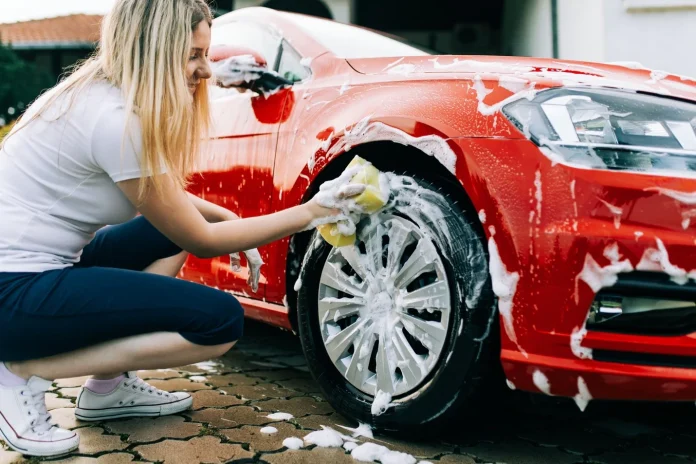As there are multiple ways to prepare an egg, there are various kinds of automobile washes. They are available close to you by using itscarwash.com And don’t assume that it will be a sign that every washing method is equal, far from it. Each has its own set of advantages and drawbacks. These pros and cons but they’re not always obvious. This is why we’ve decided to run through each washing process by separating the good from the bad aspects to help you navigate the most important aspect of car maintenance.
Method 1: Handwash
If you ask any detailing expert, they’ll inform you of the safest method of washing your car. is to hand car wash. There are many different methods that a handwash can be accomplished with a variety of options, from the traditional two-bucket method to the more modern pressurized foam cannons, however, no matter which method you choose the same thing is that you (or your detailing professional) washing the soapy water and washing your vehicle using an easy-to-handle mitt.
So, what exactly is a handwash like? In our detailing service, Simon’s Shine Shop, we begin with a pre-wash where we cover the car with the snow foam and then wash the car clean. This is not a must however, it can help us achieve better cleaning. After that, we paint the vehicle with a layer of suds. is then agitated using soft wash mitts. The foam breaks the dirt down, while the wash mitts aid in breaking them free. Then, we rinse and dry. This type of washing requires significant amounts of time, along with a wide range of equipment, and, if you’re having it done by an expert, a little of cash. However, between how soft it’s on the surface and how effective it is at removing dirt, it’s the most efficient type of car wash you could perform.
PROS:
- Reduces scratching
- Can remove heavy contamination
CONS:
- It takes longer than other methods.
- Costlier than automated washes
- It requires more equipment than other methods.
- Requires lots of water
- A challenge when you have a limited space
- It’s difficult to complete in colder temperatures.
Method 2: Waterless Wash
A waterless washing requires the spray bottle and a few microfiber towels. Spray the area using your waterless wash product and wipe the surface with a microfiber cloth. The reason people use waterless wash is various reasons. For instance, they don’t have enough space to wash their hands and they aren’t able to wash with water, they’re traveling, etc. It’s basically an option of the last option.
Why’s that? The reason is that waterless washes don’t work good at getting rid of heavy gunk. They’ll get rid of dust however, if you’ve just returned from a trip off-roading along a muddy trail, you’re probably not going to be having much luck. Another issue is their potential to scratch. Although waterless wash products are designed to smooth the surface but they’re not quite as close to the slickness that comes from an foamy handwash. There’s an excellent chance that you’ll get up and drag a particles across your surface which can cause scratches.
PROS:
- It’s not as time-consuming as handwashes or rinseless wash
- Can be accomplished with the smallest space
- Doesn’t make use of water.
- All you need is a waterless wash product and microfiber towels
CONS:
- More chances to scratch
- Can’t remove heavy contamination
Method 3: Rinseless Wash
A rinseless wash is distinct than a wash that is water-free. In a sense it’s an amalgamation between handwashes and a waterless wash. In a wash that is rinseless you’ll use a tiny amount of the rinseless wash products and blend it in an ice bucket. There won’t be any suds. This is the reason you don’t have to rinse. What you must do after you’ve washed the area is to wipe it down until dry. Rinseless washes are done using wash mitts, as well as a microfiber towel. A lot of detailers prefer using the “Garry Dean Method”, which involves soaking a number of microfiber towels inside a container that is filled with rinse-free wash product and water.
Take one towel then squeeze it dry and then set it aside to dry. After that, you spray the panel with a product that has been pre-washed and grabs a wet microfiber towel to begin cleaning. You grab your drying towel, then dry the panel, and after that, you grab a new dry microfiber to complete dry process. Repeat this process for each panel until your vehicle is completely clean. Rinseless washing is a method that is preferred by those who have water restrictions or with limited space and also those who are concerned about the scratching that a waterless wash can cause. The method still causes more scratches than a handwash, however much less than a waterless. It won’t be able to remove large amounts of dirt as you can by hand washing.
PROS:
- Could be quicker than hand washing
- Requires less water than handwash
- It requires less equipment than the handwash
- Can be done with a small space
- More resistant to scratching than a wash that is water-free
CONS:
- A handwash is more likely to cause scratches than a handwash
- Can’t remove heavy contamination
- This requires additional equipment than a simple waterless wash
Method 4: Automatic Wash
After learning from getsoapy.co.uk, johnnysautoservice.com we found, Automatic car washes also known also as “tunnel” washes, generally require the use of conveyor belts, which takes you through a sequence of blowers and brushes. The bristles on these brushes are usually contaminated by dirt and grime that were used on earlier vehicles, which could ruin the finish. They also employ harsh cleaning chemicals that could remove coatings or waxes, and dry out the paint which could cause it to start cracking and even become faded.
Why would anyone choose to make use of any of them? It’s simple: they’re cheap and quick to use and are the most well-known type of wash, simply because of their convenience. Many people either don’t understand or aren’t concerned about how they’re damaging their paintwork. It’s not necessarily bad for detailers who are professionals; however, the scratching causes a lot of people to spend money on a paintwork correction!
PROS:
- Inexpensive
- Fast
CONS:
- Causes excessive scratching
- Harsh chemicals can damage the finish
- It is not possible to eliminate heavy contamination.
Method 5: Brushless Wash
A “brushless car wash” is an automated wash that utilizes strips of soft, soft cloths as bristles to clean its machine. It’s possible that it will solve the issue of bristles that are abrasive tearing your surface, but dirty cloths are just as susceptible to scratching as hard as bristles. The dirt left by the hundreds of vehicles that preceded you could ruin your surface. Furthermore that these washes are still using those harsh chemicals that we have mentioned previously.
PROS:
- Inexpensive
- Fast
- Abrasive less than a traditional brush that has an automatic wash
CONS:
- Causes substantial scratching
- Harsh chemicals can damage the finish
- Might not be able to remove heavy contamination
Method 6: Touchless Wash
A “touchless car wash” is able to clean your vehicle without using brushes or bristles. Instead, the entire wash is carried out using chemical cleaners, pressure washers and pressurized water. Does it sound like it will solve all the issues of other automated washes? But it’s not quite that simple. One thing is that you’ll still have harmful chemicals to contend with. If you don’t want to dry your paint or strip the coating or wax, ensure you are aware prior to the time of the kind of chemicals they’re employing. Be aware that touchless washes, as well as brushless washes, use
Not
It’s identical. Many people see “brushless” and assume that is “touchless”. Do not make this mistake! Do your research prior to buying and ensure that you’re buying the correct kind of a wash.
PROS:
- Much less expensive than hand washing
- Fast
- Reduces scratching
CONS:
- More expensive than automated and brushless washes.
- Chemicals that are harsh can damage the finishing
- Might not be able to remove heavy contamination
Other Methods
We’ve seen people wash their cars using just about anything you can think of, including paper towels and Windex. Of course, it doesn’t matter if you
could
isn’t a way to say does not mean
It is recommended to
. If it’s not an everyday practice There’s likely to be some reason for that. No matter what clever idea you think of the likelihood is that it will harm your finishing. It’s not worth the effort.
Our Verdict
The most effective way to clean your car’s finish is to handwash.
It’s the least abrasive washing you can do without sacrificing quality. As with all things in life, there are times when the optimal isn’t the case. What’s the best second choice (and fourth, third and fifth)? Here’s the ranking:
- Handwash
- Touchless wash (if using gentle soap)
- Rinseless wash
- Waterless wash
- Brushless wash
- Automatic wash
Agree? Disagree? Comment below!


